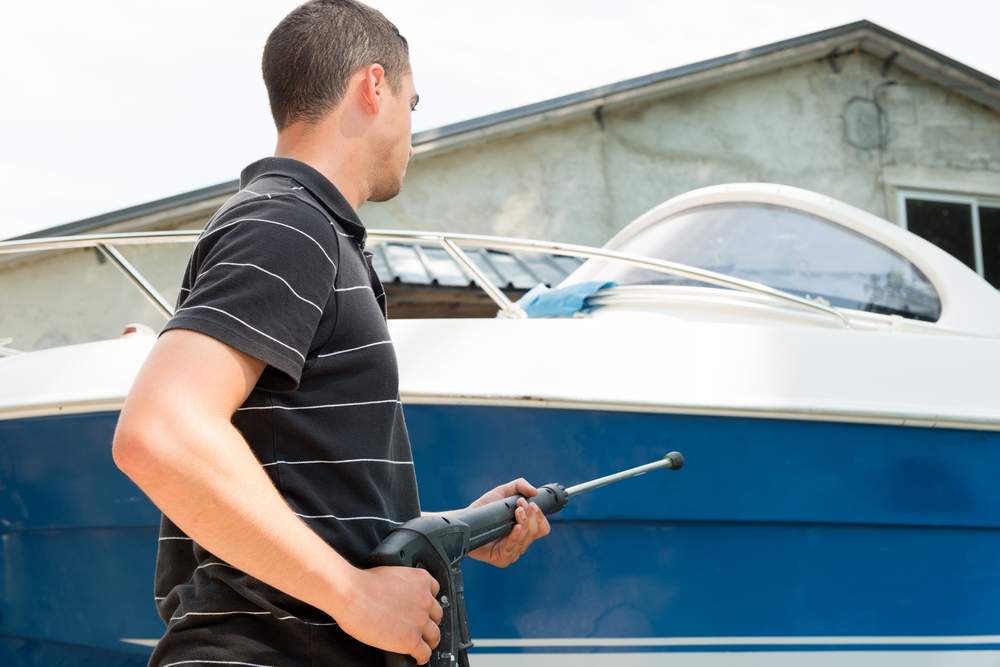
Fiberglass is a lightweight, durable material used in everything from boats and RVs to patio furniture and storage units. But when it gets dirty — covered in grime, algae, salt, or road dust — many people wonder:
Can I safely use a pressure washer on fiberglass surfaces without causing damage?
The answer is yes, but with an important caveat: you must use the right technique. While fiberglass is tough, it can be scratched, cracked, or dulled if you go too hard with pressure washing.
Let’s break down when and how to pressure wash fiberglass surfaces safely. ⚙️✨
🔍 Understanding Fiberglass
Fiberglass is made of thin glass fibers reinforced with resin, creating a smooth, water-resistant shell. This makes it ideal for outdoor applications — but also sensitive to abrasives, high pressure, and heat.
On RVs, boats, or exterior panels, fiberglass is often finished with a gel coat — a glossy outer layer that adds UV and scratch protection. If this coat is worn or damaged, the underlying fiberglass can become vulnerable.
💦 Is Pressure Washing Safe for Fiberglass?
Yes — as long as you follow these precautions:
- Use a low to moderate PSI (between 1200 and 1900 PSI)
- Use the right nozzle (typically 25° or 40°)
- Keep a safe distance between the nozzle and the surface
- Use mild, non-abrasive detergents
- Avoid spraying into vents, seams, or under trim
If done correctly, pressure washing can safely clean fiberglass without scratching or degrading the gel coat.
Browse Amazon Here For Top Rated Power Washers And Accessories
🚫 When to Avoid Pressure Washing
There are certain situations where pressure washing should be avoided:
- 🚧 Cracked or chipped fiberglass: High-pressure water can make it worse
- ☀️ Sun-damaged or oxidized gel coat: May require polishing, not pressure
- 🚿 Thin fiberglass parts (like hatch covers or lightweight trim): More prone to cracking
- ⚠️ Loose decals or paint: Can be stripped by water pressure
If in doubt, hand-wash with a microfiber cloth and biodegradable soap.
✅ Step-by-Step: How to Pressure Wash Fiberglass Safely
1. Rinse First 💧
Start with a gentle rinse to remove loose dirt and salt. This helps prevent scratching during the wash.
2. Apply a Mild Detergent 🧴
Use a fiberglass-safe cleaner or a marine/RV wash soap. Let it sit for a couple of minutes, but don’t let it dry.
3. Use the Right Nozzle & Pressure 🔫
Stick with a 25° or 40° nozzle and keep PSI under 1900. Test a small area first.
4. Keep the Right Distance 📏
Maintain at least 12–18 inches between the nozzle and the fiberglass surface.
5. Spray at a Downward Angle ↘️
This prevents water from being forced under seams or trim.
6. Rinse Gently and Evenly 🌀
Don’t linger in one spot. Use long, overlapping strokes to rinse off soap and grime.
✨ Bonus Tips for Boats and RVs
- 🚢 For boats: Use a salt remover after rinsing to reduce corrosion
- 🚐 For RVs: Clean roof first, then work your way down to avoid streaks
- 🌞 Avoid washing in direct sunlight — it can cause soap to dry too fast
🧽 Aftercare for Fiberglass Surfaces
After pressure washing:
- Dry with a soft towel or microfiber cloth
- Apply a UV protectant or gel coat wax to restore shine and protect against future damage
- Inspect for any missed spots or surface issues
This not only makes your fiberglass look great — it helps extend its life, too. ✅
🏁 Final Thoughts
You can pressure wash fiberglass — if you’re careful. The key is to balance cleaning power with surface safety. Avoid going full blast or using harsh chemicals. With the right PSI, nozzle, and a bit of patience, pressure washing can help you maintain your boat, RV, or fiberglass fixtures in tip-top shape. 🧼🚐⚓
Browse Amazon Here For Top Rated Power Washers And Accessories






